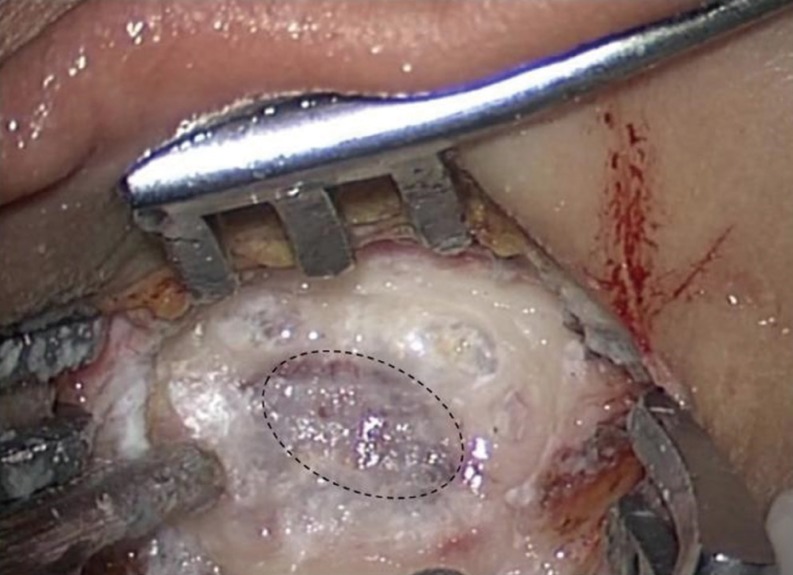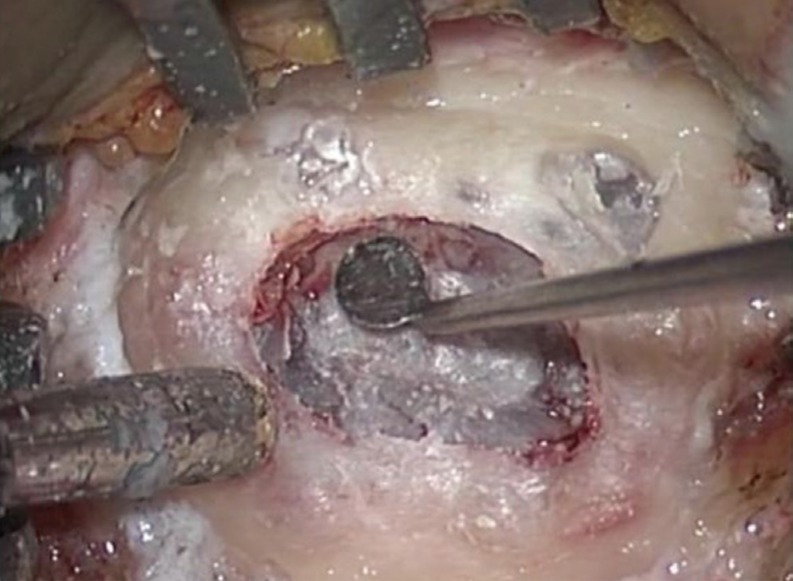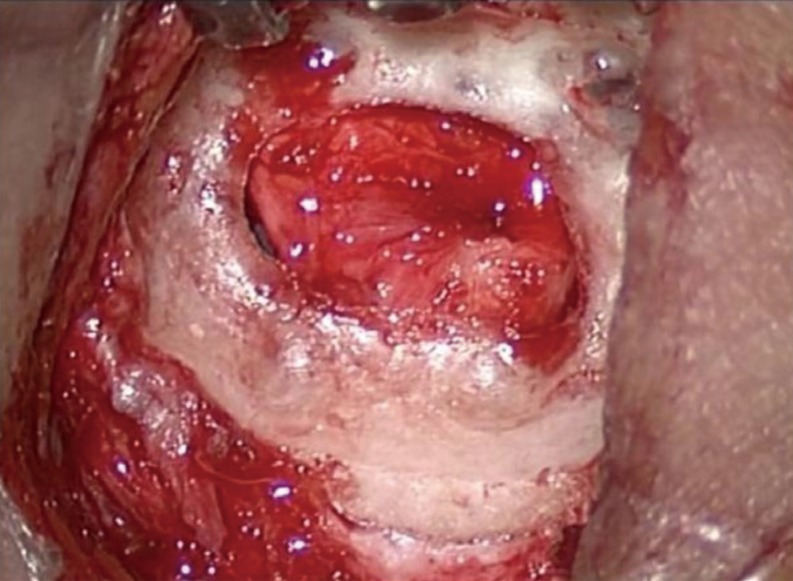Clin Exp Otorhinolaryngol.
2015 Jun;8(2):111-116. 10.3342/ceo.2015.8.2.111.
Degree of Sigmoid Sinus Compression and the Symptom Relief Using Magnetic Resonance Angiography in Venous Pulsating Tinnitus
- Affiliations
-
- 1Department of Otolaryngology, Eye Ear Nose and Throat Hospital of Fudan University, Shanghai, China. wwuqing@eent.shmu.edu.cn
- KMID: 2360780
- DOI: http://doi.org/10.3342/ceo.2015.8.2.111
Abstract
OBJECTIVES
To show that mechanical compression of sigmoid sinus is effective for treatment of pulsatile tinnitus caused by sigmoid sinus enlargement, and to evaluate the relationship between the compression degree of sigmoid sinus and the tinnitus symptom relief using magnetic resonance angiography.
METHODS
Medical records of twenty-four patients who were diagnosed with venous tinnitus caused by sigmoid sinus enlargement and underwent mechanical compression of sigmoid sinus were reviewed between April 2009 and May 2013. All these patients received computed tomography and magnetic resonance venography study before undergoing surgery and were followed for at least 4 months.
RESULTS
Twenty-three patients felt relief from tinnitus three months after the surgery, and the cross-sectional area of the sigmoid sinus on the tinnitus side was compressed approximately by half (46%-69%) after the surgery. There were 4 patients whose tinnitus suddenly disappeared while lying on the operating table before operation, which may be a result of the patient's emotional tension or postural changes from standing. One of the four patients felt no relief from tinnitus after the surgery, with the cross-sectional area of the sigmoid sinus only compressed by 30%. And two patients of them had a recurrence of tinnitus about 6 months after the surgery. Seven patients had sigmoid sinus diverticula, and tinnitus would not disappear merely by eliminating the diverticulum until by compressing the sigmoid sinus to certain degree. There were 3 minor complications, including aural fullness, head fullness and hyperacusis. The preoperative low frequency conductive and sensorineural hearing loss of 7 subjects subsided.
CONCLUSION
Mechanical compression of sigmoid sinus is an effective treatment for pulsatile tinnitus caused by sigmoid sinus enlargement, even if it might be accompanied by sigmoid sinus diverticulum. A compression degree of sigmoid sinus about 54% is adequate for the relief of tinnitus symptom. Cases in which patients' tinnitus suddenly disappeared before the surgery might be excluded to improve the efficacy of surgery.
MeSH Terms
Figure
Reference
-
1. Sismanis A. Pulsatile tinnitus. Otolaryngol Clin North Am. 2003; 4. 36(2):389–402. PMID: 12856306.
Article2. Mattox DE, Hudgins P. Algorithm for evaluation of pulsatile tinnitus. Acta Otolaryngol. 2008; 4. 128(4):427–431. PMID: 18368578.
Article3. Sismanis A. Otologic manifestations of benign intracranial hypertension syndrome: diagnosis and management. Laryngoscope. 1987; 8. 97(8 Pt 2 Suppl 42):1–17. PMID: 3302575.
Article4. Jackler RK, Brackmann DE, Sismanis A. A warning on venous ligation for pulsatile tinnitus. Otol Neurotol. 2001; 5. 22(3):427–428. PMID: 11347652.
Article5. Aikoye AA, Tang TY, Meyer FJ. Local anaesthetic surgical treatment of severe objective pulsatile tinnitus: a useful technique. Ann R Coll Surg Engl. 2012; 5. 94(4):e139–e140. PMID: 22613279.
Article6. Golueke PJ, Panetta T, Sclafani S, Varughese G. Tinnitus originating from an abnormal jugular bulb: treatment by jugular vein ligation. J Vasc Surg. 1987; 9. 6(3):248–251. PMID: 3625880.
Article7. Santos-Franco JA, Lee A, Nava-Salgado G, Zenteno M, Vega-Montesinos S, Pane-Pianese C. Hybrid carotid stent for the management of a venous aneurysm of the sigmoid sinus treated by sole stenting. Vasc Endovascular Surg. 2012; 5. 46(4):342–346. PMID: 22534612.
Article8. Otto KJ, Hudgins PA, Abdelkafy W, Mattox DE. Sigmoid sinus diverticulum: a new surgical approach to the correction of pulsatile tinnitus. Otol Neurotol. 2007; 1. 28(1):48–53. PMID: 17195746.9. Park IH, Kang HJ, Suh SI, Chae SW. Dural arteriovenous fistula presenting as subjective pulsatile tinnitus. Arch Otolaryngol Head Neck Surg. 2006; 10. 132(10):1148–1150. PMID: 17043268.
Article10. Shin EJ, Lalwani AK, Dowd CF. Role of angiography in the evaluation of patients with pulsatile tinnitus. Laryngoscope. 2000; 11. 110(11):1916–1920. PMID: 11081610.
Article11. De Ridder D, De Ridder L, Nowe V, Thierens H, Van de Heyning P, Moller A. Pulsatile tinnitus and the intrameatal vascular loop: why do we not hear our carotids? Neurosurgery. 2005; 12. 57(6):1213–1217. PMID: 16331169.
Article12. Sismanis A. Pulsatile tinnitus: a 15-year experience. Am J Otol. 1998; 7. 19(4):472–477. PMID: 9661757.13. Krishnan A, Mattox DE, Fountain AJ, Hudgins PA. CT arteriography and venography in pulsatile tinnitus: preliminary results. AJNR Am J Neuroradiol. 2006; 9. 27(8):1635–1638. PMID: 16971601.14. Madani G, Connor SE. Imaging in pulsatile tinnitus. Clin Radiol. 2009; 3. 64(3):319–328. PMID: 19185662.
Article15. Davies MA, Saleh J, Ter Brugge K, Willinsky R, Wallace MC. The natural history and management of intracranial dural arteriovenous fistulae. Part 1: benign lesions. Interv Neuroradiol. 1997; 12. 3(4):295–302. PMID: 20678360.16. Eisenman DJ. Sinus wall reconstruction for sigmoid sinus diverticulum and dehiscence: a standardized surgical procedure for a range of radiographic findings. Otol Neurotol. 2011; 9. 32(7):1116–1119. PMID: 21799456.17. Duvillard C, Ballester M, Redon E, Romanet P. Pulsatile tinnitus cured by mastoidectomy. Ann Otol Rhinol Laryngol. 2004; 9. 113(9):730–733. PMID: 15453531.
Article
- Full Text Links
- Actions
-
Cited
- CITED
-
- Close
- Share
- Similar articles
-
- A Case of Pulsatile Tinnitus by Sigmoid Sinus Diverticulum
- Pulsatile Tinnitus with a Dural Arterio-Venous Fistula Diagnosed by Computed Tomography-Angiography
- A Case of Lateral Sinus Thrombosis Presenting with Cranial Nerve Syndrome
- A Case of Surgically Treated Pulsatile Tinnitus by Sigmoid Sinus Diverticulum and/or Dehiscence (SSDD)
- Early Spontaneous Recanalization of Sigmoid Sinus Thrombosis Following a Closed Head Injury in a Pediatric Patient : A Case Report and Review of Literature





